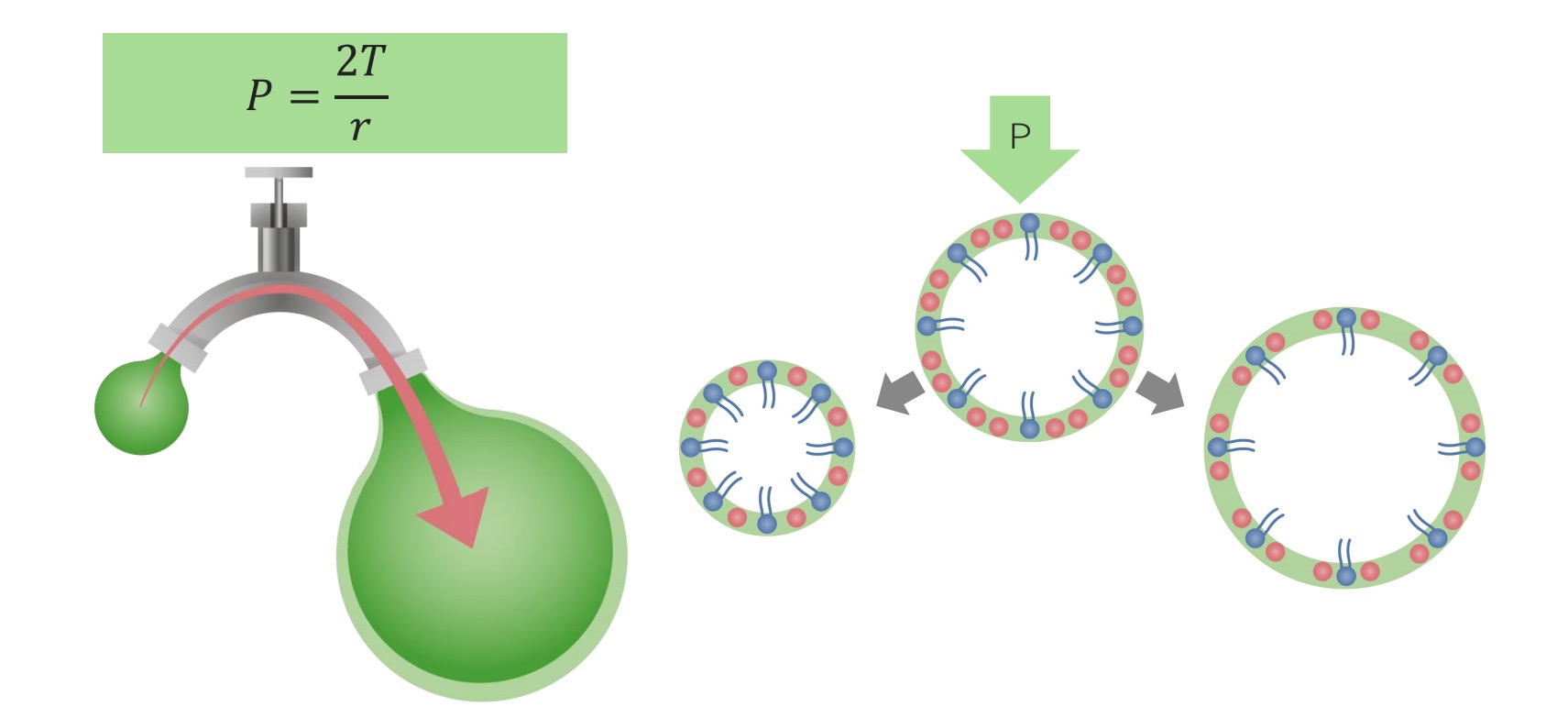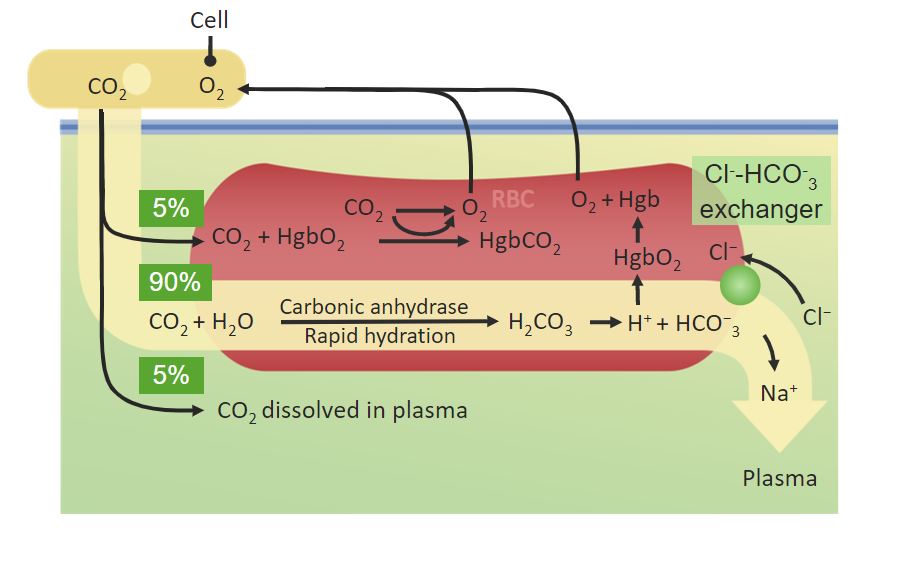Playlist
Show Playlist
Hide Playlist
Hemoglobin and O₂ Binding – Gas Transport
-
Slides Gas Transport.pdf
-
Download Lecture Overview
00:01 How do you do or how do you carry the blood? It’s bound to hemoglobin. 00:06 So hemoglobin is a molecule in which there are four binding sites for oxygen and these are denoted here as first binding site, second binding site, third binding site and finally having all four bound. 00:19 And what’s unique about these particular binding sites is that the affinity for O2 increases as the number of molecules of oxygen are bound. 00:28 So having three molecules bound, you have a higher propensity to get a fourth molecule bound than you had with if you only have one. 00:40 And this is a unique property and what it does is it makes for a non-linear relationship between the amount of oxygen available and the amount bound to hemoglobin. 00:50 And I can show you that relationship in the next few slides. 00:55 This sets up the sigmoidal curve which is the oxygen-hemoglobin dissociation curve. 01:02 And this is probably one thing that I know you probably seen before in other classes that you've attended and other information. 01:08 But we’re going to add a few things to this particular curve that you may not have had before. 01:15 So you’ll notice that there are two Y axes. 01:16 So let’s start off with the first Y-axis. 01:20 This is going to be the percent of hemoglobin or percent of the hemoglobin that is bound. 01:27 So you can have up to 100 percent of your hemoglobin bound all the way down to 0. 01:33 On the second Y axis, we have the amount of O2 in terms of a concentration or some people like to call it a content. 01:41 And that’s going to be the millilitres of O2 per 100 mLs of blood. 01:45 And so this is a content value and the other is a percent value. 01:51 On the X-axis here, we have the PO2, which is going to be the partial pressure of oxygen. 01:58 So let’s kind of walk through this oxygen hemoglobin binding and we’ll be able to understand better how changes might occur. 02:08 Hopefully, you’re able to see that you can bind upwards to about 19, maybe even close to 20 milliliters of O2 per 100 mLs of blood. 02:19 So in that case, that is compatible with life to be able to carry that much O2. 02:23 Because remember in the dissolved form, it was only around 0.25 milliliters of O2 per 100 mLs of blood. 02:30 So this is carrying a vast majority or, in fact, about 98 percent of the total oxygen carried is in the bound form. 02:43 So, hopefully, you also can see on this particular graph that there is a kind of a large area in which PO2 can change without much changing in O2 sat or in the O2 concentration. 02:59 And that kind of flat area of the curve is usually where people will think about what’s on the arterial side of the circulation. 03:08 It’s fairly flat up on that side. 03:11 On the venous side of the circulation is just when it starts to fall. 03:16 So usually, you start off with close to a 100% saturation, you return on the venous side with maybe 75% saturation. 03:25 So you’re only utilizing that top portion of the oxygen-hemoglobin dissociation curve. 03:31 But if you look at PO2 numbers on the arterial side of the circulation, you might’ve started out at 95 PaO2 and returned at PVO2 of only 40. 03:44 So there is about there 55 millimeters of mercury of O2 that were changed and you only had about 25% change in your O2 saturation. 03:55 So why is this so important? What it does is it allows you to have quite a bit of reserve, so you could extract more O2 in certain conditions in where you needed more metabolism. 04:09 So in those cases where you were going to extract more O2, PVO2 would be at a much lower level, maybe O2 saturation would drop to 50% and you would still be able to garner enough oxygen to your peripheral tissues. 04:28 Besides this binding, there is another component that we need to add and this component is known as a P50. 04:35 This P50 is the 50% saturation point of the oxygen hemoglobin dissociation curve. 04:44 And we talk about P50 a lot, because it’s a good index to telling us which way a curve might shift, like a rightward shift in the PO2 curve is denoted by an increase in the P50. 04:57 While a leftward shift in the curve is denoted by a decrease in the P50. 05:02 So let’s go through what those P50 changes might look like. 05:08 Okay, when we look at a leftward shift in the curve, we’re actually moving in this direction. 05:12 So the leftward shift involves a decrease in the P50. 05:20 This allows for a little bit greater loading of oxygen on the flat portion of the curve, but what it does is allows for a steeper portion on the left hand side of the curve. 05:36 Why this is so helpful is it-- what I’d think of it as is it’s helping the lung to bind O2 but the problem is it’s not letting oxygen off at the peripheral tissue level. 05:50 So this can be problematic. 05:52 If you’re not letting oxygen be released, you’re holding onto it, peripheral tissues are not getting as much oxygen with a leftward shift in the oxygen-hemoglobin dissociation curve. 06:04 A rightward shift though does the opposite. 06:08 In this case, you’re moving the curve in this direction, which causes an increase in the P50. 06:15 The lung size changes drop slightly, but the tissue effect is very great. 06:22 And that tissue effect allows you to offload more O to it any given partial pressure of O2. 06:30 So this is a very handy way to deliver more oxygen to peripheral tissues. 06:35 So when might you need more delivery of oxygen to peripheral tissues? There are four primary conditions in which this happens. 06:44 The first is as you increase temperature, you cause a rightward shift in the oxygen hemoglobin dissociation curve. 06:51 As you decrease temperature, you cause a leftward shift. 06:55 CO2 as you increase the amount of CO2, you cause a rightward shift in the oxygen-hemoglobin dissociation curve. 07:06 As you decrease pH or increase the amount of hydrogen ions, you also cause a rightward shift in the oxygen hemoglobin dissociation curve. 07:16 And the final way is if you increase a metabolite of red blood cells which is 2,3 DPG or some people refer to it as BPG. 07:26 This will also cause a rightward shift in the oxygen hemoglobin dissociation curve. 07:31 So that’s associated with metabolism in the red blood cell itself. 07:34 This usually only occurs as you ascend to higher and higher altitudes. 07:40 The first three occur during sea level, which is the changes in temperature, CO2 and hydrogen ions. 07:49 Now, the last aspect of the oxygen hemoglobin dissociation curve that we need to deal with is if you have changes in the amount of hemoglobin that two or more people might have have. 08:03 And this is clinically important especially when someone has either carbon monoxide poisoning or has an anemia. 08:12 So let’s go through with the normal responses first. 08:14 So normally, a person might have a hemoglobin level of around 15 grams per 100 mLs of blood per decilitre. 08:23 And this shows a nice oxygen hemoglobin dissociation curve. 08:26 You’ll notice we have our two Y axes set up on the graph. 08:30 The percent O2 is fully bound at a 100%. 08:36 And notice that that corresponds to around 20 milliliters of O2 per 100 mLs of blood. 08:43 Let’s contrast that to someone who has a disease such as polycythemia. 08:47 This is an increase amount of hemoglobin. 08:50 The O2 sat goes still at 100%. 08:54 But now, it’s carrying more O2. 08:58 Because now, maybe that is 25 mLs of O2 per 100 mLs of blood. 09:05 Let’s contrast that to someone who has anemia. 09:07 You can still have a 100% percent saturation of the amount of hemoglobin that you have, but that, well, maybe only accounts to 12 milliliters of oxygen per 100 mLs of blood. 09:18 This looks a lot like someone who has carbon monoxide poisoning. 09:22 You can still have a 100% saturation and not carry that much O2 and the reason for that is carbon monoxide binds to those oxygen binding sites on hemoglobin with a greater affinity than what oxygen does. 09:39 And therefore, they will preferentially bind to those binding sites and prevent O2 from binding to them. 09:46 So it looks a lot like the person has an anemia in terms of the plateau portion of the oxygen-hemoglobin dissociation curve. 09:55 The one aspect that’s a little bit different is it causes a leftward shift in the oxygen hemoglobin dissociation curve, which means that peripheral tissue have harder time being able to get oxygen from that particular red blood cell as it travels through this circulation.
About the Lecture
The lecture Hemoglobin and O₂ Binding – Gas Transport by Thad Wilson, PhD is from the course Respiratory Physiology.
Included Quiz Questions
How many oxygen molecules can bind to one hemoglobin protein?
- 4
- 1
- 2
- 3
- 5
Why does the oxygen-hemoglobin dissociation curve have a sigmoidal shape?
- As each oxygen binds to hemoglobin the affinity for the next oxygen is increased.
- As each oxygen binds to hemoglobin the affinity for the next oxygen is decreased.
- As each oxygen unloads from hemoglobin the affinity for the next oxygen is increased.
- As each oxygen binds to hemoglobin the dissolved content of oxygen increases.
- As each oxygen binds to hemoglobin the dissolved content of oxygen decreases.
Which of the following variables changes when a person with polycythemia is at 100% saturation?
- The oxygen concentration
- The partial pressure of oxygen
- The partial pressure of carbon dioxide
- The bicarbonate concentration
- The dissolved arterial oxygen content
Which of the following factors shift the oxygen hemoglobin curve to the left?
- Increase in pH
- High temperature
- High concentration of CO2
- Decrease in pH
- Increase in 2,3 DPG
Which of the following factors will shift the oxygen hemoglobin curve to the right?
- A decrease in pH
- A decrease in body temperature
- A decrease in hydrogen ion concentration
- A decrease in CO2 concentration
- A decrease in 2,3 DPG
Customer reviews
5,0 of 5 stars
| 5 Stars |
|
1 |
| 4 Stars |
|
0 |
| 3 Stars |
|
0 |
| 2 Stars |
|
0 |
| 1 Star |
|
0 |
Clearly explained the key concepts - not too wordy and presented with clear diagrams!





